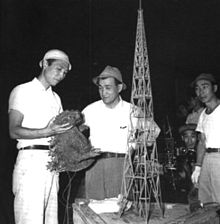- Ishiro Honda
-
 Ishiro Honda.
Ishiro Honda.
Ishirō Honda también conocido como Inoshiro Honda (本多猪四郎? 7 de mayo de 1911 en la prefectura de Yamagata - 28 de febrero de 1993) fue un director de cine japonés.
Es probablemente más conocido por sus películas tokusatsu, entre las que se incluyen varias de la serie Godzilla. Dirigió el Gojira original además de Rey Kong contra Godzilla (1962), Mothra contra Godzilla (1964), La Venganza de Godzilla (1969) y muchos otras hasta 1971. También dirigió otros tokusatsu tales como Rodan y Mothra. Algunos capítulos televisivos de las series de super-héroes El Retorno de Ultraman, Mirrorman y la Zona del Hombre Meteorito son también suyos. Además, dirigió la película de culto Matango.
Ishiro Honda también trabajó con el famoso director japonés Akira Kurosawa de quien era amigo cercano, como director auxiliar en varios proyectos, incluyendo Stray Dog , Kagemusha, Ran, y Dreams.
Su cita más memorable: “Los monstruos nacen demasiado grandes, demasiado fuertes, demasiado pesados, ésa es su tragedia”, en referencia a su película, Rodan. Esta afirmación daría a los seguidores la impresión de que intentó dar a todo el daikaiju una personalidad distinta en vez de mostrar tan solo a monstruos sueltos.
Filmografía
- A Story of a Co-Op
- Ise Island
- Aoi shinju (también conocida como The Blue Pearl)
- Nangoku no hada (también conocida como The Skin of the South)
- Minato e kita otoko (también conocida como The Man Who Came to Port)
- Zoku shishunki (también conocida como Adolescence Part II)
- Taiheiyo no washi (también conocida como Eagle of the Pacific)
- Saraba Rabauru (también conocida como Farewell Rabaul)
- Gojira (1954) (también conocida como Godzilla) (1954)
- Koi-gesho (también conocida como Love Makeup)
- Oen-San (también conocida como Cry-Baby)
- Jū jin yuki otoko (1955) (también conocida como Beast Man Snow Man or Half Human: The Story of the Abominable Snowman)
- Wakai Ki (también conocida como Young Tree)
- Night School (1956 film) (también conocida como Yakan chugaku)
- Godzilla, King of the Monsters! (1956) (US edition of Gojira)
- Tokyo no hito sayonara (también conocida como People of Tokyo, Goodbye)
- Sora no daikaijū Radon (también conocida como Rodan) (1956)
- Chikyu Boeigun (también conocida como The Mysterians or Defence Force of the Earth) (1957)
- Bijo to Ekitainingen (o The H-Man) (1958)
- Daikaijū Baran (o Varan the Unbelievable)(1958)
- Uchu daisenso (o Battle in Outer Space) (1959)
- The Human Vapor (1960)
- Mosura (o Mothra) (1961)
- Yosei Gorasu (o Gorath) (1962)
- King Kong vs. Godzilla (1962)
- Matango (también conocida como Attack of the Mushroom People) (1963)
- Kaitei Gunkan (o Atragon) (1963)
- Mothra vs. Godzilla (también conocida como Godzilla vs. Mothra or Godzilla vs. the Thing) (1964)
- Uchu Daikaijū Dogora (también conocida como Dogora the Space Monster) (1964)
- San Daikaijū - Chikyū Saidai no Kessen (también conocida como Ghidorah, the Three-Headed Monster) (1964)
- Furankenshutain tai Chitei Kaijû "Baragon" (o Frankenstein Conquers the World) (1965)
- Kaiju Daisenso (también conocida como Invasion of Astro-Monster o Monster Zero or Godzilla vs. Monster Zero) (1965)
- Furankenshutain no Kaijū: Sanda tai Gaira (también conocida como War of the Gargantuas) (1966)
- Kingu Kongu no Gyakushū (también conocida como King Kong Escapes) (1967)
- Kaijū Sōshingeki (también conocida como Destroy All Monsters) (1968)
- Gojira Minira Gabara Ōru Kaijū dai Shingeki (también conocida como All Monsters Attack o Godzilla's Revenge) (1969)
- Ido zero daisakusen (también conocida como Latitude Zero) (1969)
- Space Amoeba (también conocida como Yog monster from space) (1970)
- Mekagojira no Gyakushû (o Terror of Mechagodzilla) (1975)
Categorías:- Nacidos en 1911
- Fallecidos en 1993
- Directores de cine de Japón
Wikimedia foundation. 2010.

